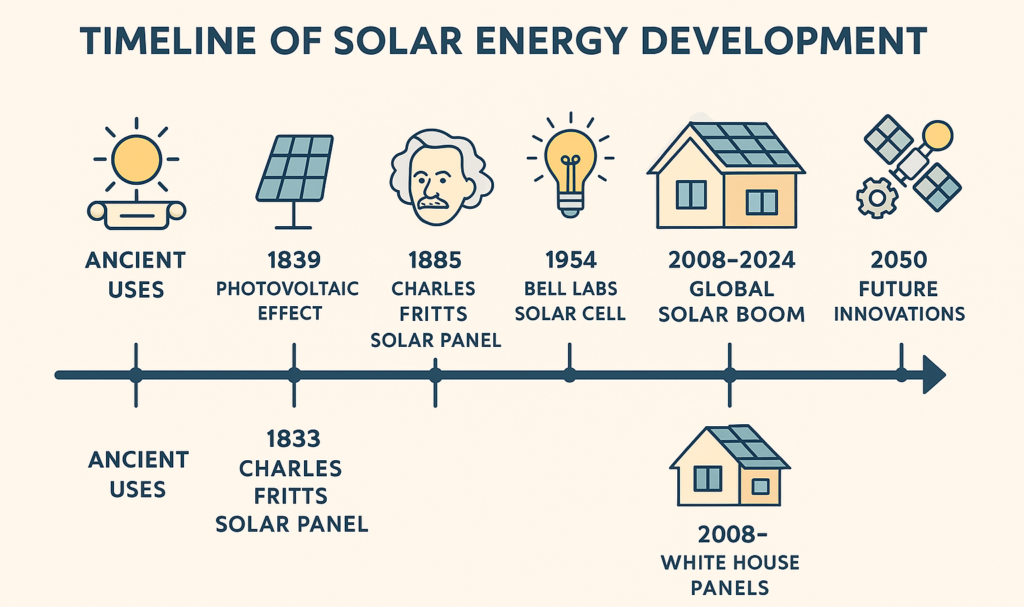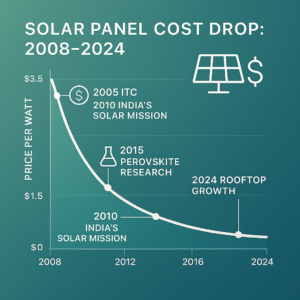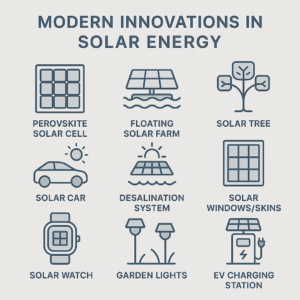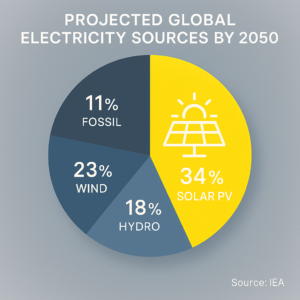Solar energy refers to the conversion of sunlight into usable heat or electricity using modern technologies like photovoltaic (PV) panels and solar thermal systems. It’s a clean, renewable source of power that plays a key role in the global shift toward sustainable energy.
Today, solar arrays are more popular than ever, powering millions of homes, businesses, and even entire cities. But the journey of solar energy didn’t begin in the 21st century—it’s a story that spans centuries of scientific discovery, innovation, and trial.
In this article, you’ll discover:
- Early Years (Before the 1800s): How civilisations first observed and used solar energy
- 1800s–1900s: When early scientists began experimenting with sunlight and electricity
- 1900s–2000: The invention of the first true solar system and its evolution
- 2000–Present: The rise of home solar systems and mainstream solar uptake
- Future of Solar: Where the technology is headed and what innovations are coming
- When Was the First Solar Panel Invented? – A look at Charles Fritts and early breakthroughs
- When Was the First Solar House Built? – Key moments in residential solar history
Let’s dive into the fascinating history of solar power from its ancient roots to the cutting-edge technologies driving our solar future.
Early Years (Before 1800s)
The history of solar energy goes back thousands of years—long before the invention of solar arrays.
In ancient India, Vastu-Shastra guided home designs to use sunlight for natural heating and cooling. Traditional houses, especially in Rajasthan, used courtyards, thick walls, and jalis to regulate temperature using passive solar principles.
Early civilizations recognized the sun’s power and found clever ways to use it for heat, fire, and light.
- Some of the earliest documented uses of solar energy involved concentrating sunlight to spark fire. Ancient Greeks and Chinese civilizations used burning mirrors—curved, reflective surfaces—to focus sunlight and ignite combustible materials.
- Several ancient societies mastered passive solar heating using architecture to collect and retain solar heat for heating and cooking.
- The Romans built “sunrooms” in bathhouses and villas, using large south-facing windows to capture and store solar warmth during winter.
- Ancient Greeks and Chinese oriented buildings toward the sun to naturally heat indoor spaces.
- The Ancestral Puebloans (Anasazi) built entire cities beneath south-facing cliffs, using the rock face to absorb daytime heat and radiate it at night, a sustainable design still admired today.
- Ancient Egyptians used solar evaporation to dry crops and cool their homes by directing breezes through shaded, sun-cooled areas.
- In 1767, Horace-Bénédict de Saussure, a Swiss physicist, created the first solar collector, now known as the solar oven — one of the earliest scientific uses of solar energy.
These examples show that long before electricity, humans understood how to harness the sun in practical and innovative ways.
1800–1900s: The Scientific Foundation of Solar Power
The 19th century marked the beginning of solar energy as a formal scientific field. Through a series of groundbreaking discoveries, researchers began to understand how sunlight could be converted directly into electricity, laying the foundation for modern PV system technology.
1839: Discovery of the Photovoltaic Effect : Edmond Becquerel, a French physicist, discovered the PV effect. This marked the first recorded step toward converting sunlight into electricity. Becquerel is often called the “father of solar”.You can read more about this pivotal moment in solar history in Scientific American’s article on the first solar cell.
1873: Selenium’s Photoconductivity : Willoughby Smith found that selenium became more conductive in light. This proved that light could directly affect electrical behaviour, critical to solar cell development, such as those found in the IEEE Engineering and Technology History.
1876: Selenium Generates Electricity : William Grylls Adams and Richard Evans Day showed that selenium could generate electricity from sunlight—offering the first direct evidence of light producing usable electrical energy.
1883: First PV System Prototype : Charles Fritts built the first solar cell using selenium and gold. Though under 1% efficient, it was the first device to convert sunlight into electricity—seen as the invention of the first solar array and a milestone in the history of solar energy.
1900–2000: The Rise of Modern Solar Technology
The 20th century witnessed the transformation of solar power from theoretical science into a viable global energy solution. From Einstein’s photoelectric theory to satellites powered by solar cells, this era shaped the foundation of today’s solar revolution.
1905: Einstein & the Photoelectric Effect
In 1905, Albert Einstein published a paper explaining the photoelectric effect, proving that light could release electrons from a material surface. This helped validate how solar energy works at the atomic level, laying the groundwork for solar PV technology. Einstein later won the Nobel Prize in Physics (1921) for this contribution.
🔗 Nobel Prize Organisation – Einstein’s Work on the Photoelectric Effect
1939: MIT’s Solar House I
MIT scientists built Solar House I, one of the first research projects using solar thermal energy for residential heating. It pioneered the idea that solar could support domestic energy needs, well before the invention of modern solar modules.
🔗 MIT Energy Initiative – History of Solar Projects
1954: The First Silicon Solar Cell by Bell Labs
The first practical solar cell was developed in 1954 by Daryl Chapin, Calvin Fuller, and Gerald Pearson at Bell Labs. Made from silicon, the cell could convert sunlight into electricity with 6% efficiency, launching the modern solar array era.
🔗 Energy.gov – History of Solar Energy
1958–1964: Solar Panels in Space
- 1958: The Vanguard I satellite became the first to use PV system for power, proving solar’s reliability in space.
- It was followed by Vanguard II, Explorer III, and Sputnik-3, all equipped with solar technology.
- 1964: NASA launched the Nimbus satellite, powered entirely by solar energy.
These milestones proved that solar was suitable for critical, real-world applications, like powering satellites in orbit.
🔗 NASA – Solar Power in Space Missions
1963–1970s: Mass Production Begins
- 1963: Japan’s Sharp Corporation began mass production of solar cells, making solar technology commercially available.
- The 1970s oil crisis and the growing environmental movement sparked serious government and academic investment in alternative energy sources, including solar.
1973–1979: Innovation & Policy Support
- 1973: The University of Delaware built “Solar One,” the first solar-powered residential building.
- 1976: Thin-film solar cell production began, cheaper and more flexible than traditional silicon cells.
- 1977: The National Renewable Energy Laboratory (NREL) was established to lead U.S. solar innovation.
- 1978: The U.S. passed the Energy Tax Act, encouraging solar adoption through tax credits.
- 1979: President Jimmy Carter installed solar arrays on the White House, a symbolic step toward national energy independence.
1980s: Solar Takes to the Skies
- 1981: The Solar Challenger, a solar-powered aircraft, successfully flew from France to England.
- 1982: The Quiet Achiever, an Australian solar car, completed a 2,500-mile journey, proving solar’s potential for transportation.
1990s: National Solar Programs Expand
- 1994: Japan launched the 70,000 Solar Roofs Program, incentivizing residential solar.
- 1999: Germany followed with the 100,000 Solar Roofs Program, laying the groundwork for Europe’s solar boom.
These initiatives demonstrated how government-backed policies could rapidly scale solar energy use for homes.
🔗 IEA – Solar PV Country Profiles
2000–Present: The Global Solar Boom
The 21st century brought solar energy into the mainstream, driven by falling costs, supportive policies, and major technological advancements.
Solar Energy History and Growth in India
- 2008–2010: Launched the Jawaharlal Nehru National Solar Mission (JNNSM) to install 20 GW of solar capacity by 2022.
- 2015: India co-founded the International Solar Alliance (ISA) to promote solar adoption globally.
- 2022: India crossed 60 GW of installed solar capacity, ranking in the world’s top five solar markets.
- 2024–25: Launched the PM Surya Ghar: Muft Bijli Yojana offering subsidies and free electricity for rooftop solar users.
- Target: According to the Ministry of New and Renewable Energy (MNRE) India aims for 280 GW of solar capacity by 2030, led by utility-scale and rooftop installations.
2005: U.S. Investment Tax Credit (ITC)
The Energy Policy Act of 2005 created the Investment Tax Credit (ITC), offering 30% tax incentives for residential and commercial solar installations. It became a key driver for solar deployment in the U.S.
2006: California Solar Initiative
The California Solar Initiative (CSI) launched one of the largest state-led solar programs, setting ambitious goals to install over 3,000 MW of solar capacity by 2017.
2008: Solar Returns to the White House
President Barack Obama reinstalled the panels on the White House, symbolising national commitment to clean energy.
2008–2015: Massive Drop in Solar Costs
Between 2008 and 2015, solar module prices fell by approximately 85%, making solar energy cost-competitive with fossil fuels. This era marked the shift from niche to mainstream adoption.
According to Dr. Varun Sivaram, energy policy expert and author of Taming the Sun, “This period wasn’t just about falling costs—it was a tipping point. Solar became not only cheaper but also scalable, flexible, and globally viable. It changed the economics of energy forever.”
Present Day: Millions of Solar Homes
Growth of Residential Solar Installations in India (2010–2024)
| Year | Cumulative Residential Solar Capacity (MW) | Estimated No. of Homes with Rooftop Solar |
| 2010 | <1 MW | ~1,000 homes |
| 2015 | ~100 MW | ~20,000 homes |
| 2017 | ~420 MW | ~75,000 homes |
| 2019 | ~1,600 MW | ~275,000 homes |
| 2021 | ~2,500 MW | ~450,000 homes |
| 2023 | ~3,800 MW | ~650,000 homes |
| 2024 (est.) | 5,000+ MW | ~1 million+ homes |
Data is rounded and based on publicly available sources including MNRE, CEEW, and market reports.
Recent Innovations in Solar Technology
- Perovskite Solar Cells (PSC) : These next-gen solar cells promise higher efficiency, flexibility, and lower costs than traditional silicon.
- Floato-voltaics : Solar modules installed on water bodies (like reservoirs) reduce land use and improve cooling efficiency.
- Other Cutting-Edge Technologies : Solar Desalination, Solar Trees, Solar Cars, Solar Skins, Solar Windows
- Solar is now embedded in everyday items such as: Solar chargers and lanterns, Solar-powered water heaters, Garden lights, Smartwatches and calculators, and Streetlights and traffic signals etc.
Future of Solar: Innovation, Growth & Global Adoption
The future of solar energy is set to outpace all other energy sources—driven by innovation, affordability, and its role in achieving net-zero goals.
- Ongoing Growth & Market Expansion : According to the International Energy Agency (IEA), solar PV is expected to be the world’s largest source of electricity by 2050. Nations are scaling up large solar farms, while distributed solar systems continue growing in homes and businesses.
🔗 IEA – Renewables 2023 Report
- Technological Advancements Driving the Future : The future is being shaped by powerful solar technologies, including-Perovskite solar cells, Bifacial panels, Solar windows and skins/Films, and Solar storage systems.
- Continued Decline in Costs but Rising Efficiency : The cost of solar has dropped more than 90% since 2010, while average efficiency has improved from ~15% to 22%+ for leading modules. This trend makes solar one of the most affordable and competitive energy sources globally.
🔗 NREL – Solar Energy Cost Trends
- Beyond Homes: Industry & Transport : Solar is no longer limited to rooftops. It’s powering- Factories & Data Centres, Electric vehicle & charging stations, Agrivoltaics, Solar-powered railways, cars, and marine vessels.
India’s Solar Future:
India is rapidly emerging as a global solar leader with ambitious targets and strong government support. For homeowners and businesses alike, now is the ideal time to invest in solar energy.
- Explore India’s rooftop solar incentives: solarrooftop.gov.in
- Learn how to install a rooftop solar system in your area
Conclusion: From Sunrooms to Satellites — The Enduring Journey of Solar Energy
The history of solar energy is a story of human innovation spanning ancient civilisations, 19th-century scientific breakthroughs, and 21st-century global adoption.
From Charles Fritts’ invention of the first solar module in 1883 to today’s cutting-edge perovskite cells and floating solar farms, solar power has evolved into one of the most important solutions for a sustainable future.
What began as simple passive heating is now powering millions of homes, spacecraft, and entire cities, driven by falling costs, rising efficiency, and bold innovation.
As we move toward a net-zero world, solar energy will remain a cornerstone of environmentally friendly electricity, helping combat climate change and reshape how we power our planet.
The sun has always been there. Today, we finally know how to use it, smarter, cleaner, and at global scale.
Frequently Asked Questions (FAQs)
When Was the First Solar Panel Invented?
In 1883, American inventor Charles Fritts built the first solar arrays by coating selenium with a thin layer of gold—marking the earliest milestone in the modern solar energy timeline.
When was the first solar house built?
The first solar-powered house was built in 1939 and was known as “Solar House I”. It was designed and constructed by Dr. Harlan T. Swanson and researchers at the Massachusetts Institute of Technology (MIT).





